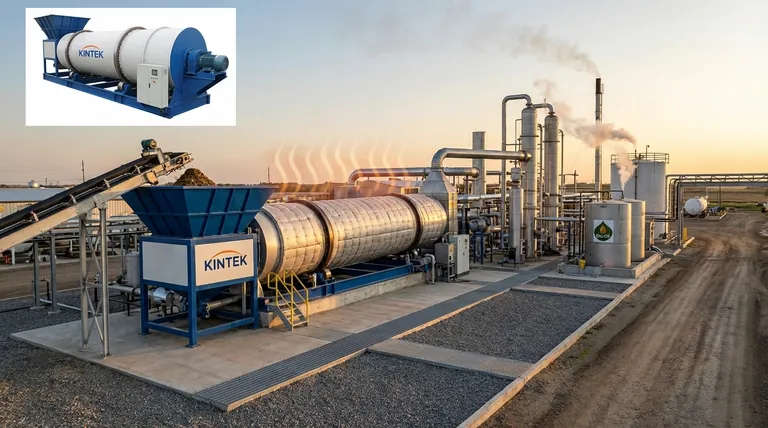In practice, pyrolysis faces significant challenges that span economics, engineering, and fundamental chemistry. The primary hurdles include high capital and operating costs, technical difficulties in scaling the process from the lab to an industrial scale, the chemical instability of its liquid product (bio-oil), and managing inconsistent feedstock quality.
While pyrolysis holds immense promise for converting waste into valuable resources, its real-world implementation is often hindered by a critical gap between theoretical potential and practical, cost-effective operation at scale.

The Economic Hurdles: Scaling and Profitability
The financial viability of a pyrolysis plant is a primary concern that dictates its feasibility. The high costs are not just in the initial build but are present throughout the plant's operational life.
High Capital and Operating Costs
Building a pyrolysis facility requires a significant upfront investment in reactors, feedstock handling systems, and product collection equipment. Ongoing operational costs, including energy inputs, maintenance, and labor, can also be substantial, impacting the overall profitability.
The Challenge of Small-Scale Economics
For smaller plants, the economics are even more challenging. While upgrading pyrolysis products into higher-value chemicals could improve profitability, the added complexity and cost of these downstream processes are often difficult to justify at a smaller scale.
The Engineering and Technical Barriers
Translating a successful lab-scale pyrolysis process into a reliable, large-scale industrial operation presents several engineering obstacles.
Scaling Up: From Lab to Industry
What works efficiently in a controlled laboratory setting often faces unexpected technical difficulties when scaled up. Ensuring uniform heat transfer, managing material flow, and maintaining process stability in a large reactor are complex engineering problems that require significant expertise to solve.
Managing Inconsistent Feedstock
Pyrolysis is often proposed for variable waste streams like biomass or mixed plastics. However, this feedstock variability is a major challenge, as changes in composition, moisture content, and particle size directly affect the quality, consistency, and yield of the final products.
The Challenge of Product Uniformity
Similar to other thermal decomposition processes, achieving a perfectly uniform product is difficult. Variations in reaction conditions can lead to a heterogeneous mix of outputs, complicating separation and upgrading efforts and reducing the final value.
The Chemical Instability of Pyrolysis Products
Perhaps one of the most underestimated challenges is the nature of the primary liquid product itself: pyrolysis oil, or bio-oil.
The Inherent Instability of Bio-oil
Pyrolysis oil is not a finished, stable product like crude oil. It is a complex mixture of reactive organic compounds that continue to change over time. This inherent instability is a major drawback for storage and transportation.
Degradation During Storage and Heating
During storage, bio-oil's viscosity gradually increases, and it can even separate into different phases due to slow condensation reactions. If heated for further processing, these reactions accelerate rapidly, producing solid residues and releasing volatile organic compounds (VOCs), which complicates its use as a fuel or chemical feedstock.
Understanding the Trade-offs and Risks
A clear-eyed view of the risks is essential for any potential pyrolysis project. The technology is not a magic bullet and comes with significant operational and environmental considerations.
Environmental and Safety Concerns
If not properly controlled, pyrolysis systems can release harmful pollutants. These include particulate matter (soot) and volatile organic compounds (VOCs), which require robust gas clean-up systems, adding to the plant's cost and complexity.
Product Quality vs. Process Cost
There is a constant trade-off between the cost of the process and the quality of the products. Achieving high yields of a stable, valuable product often requires more advanced reactors, tighter process controls, and extensive downstream upgrading, all of which drive up the cost.
Navigating Pyrolysis for Your Application
To make an informed decision, you must align the technology's capabilities with your primary objective. Different goals place emphasis on solving different challenges.
- If your primary focus is waste volume reduction: Concentrate on the reliability, throughput, and operational costs of the core reactor, as product quality is a secondary concern.
- If your primary focus is energy production from bio-oil: Prioritize developing a strategy for managing oil instability, such as immediate on-site use, to avoid storage and degradation issues.
- If your primary focus is high-value chemical production: Be prepared for significant investment in feedstock pre-treatment and sophisticated downstream purification systems to ensure product consistency.
Ultimately, successfully deploying pyrolysis requires a holistic understanding of its limitations from the very beginning.
Summary Table:
| Challenge Category | Key Issues |
|---|---|
| Economic Hurdles | High capital/operating costs, poor small-scale economics |
| Technical Barriers | Scaling up from lab to industry, inconsistent feedstock, product uniformity |
| Chemical Instability | Bio-oil degradation during storage and heating |
| Risks & Trade-offs | Environmental/safety concerns, cost vs. product quality balance |
Ready to navigate the complexities of pyrolysis in your lab? KINTEK specializes in providing robust lab equipment and consumables tailored for thermal processes like pyrolysis. Whether you're focused on waste reduction, energy production, or chemical synthesis, our expertise and reliable equipment can help you overcome scaling and technical challenges. Contact our experts today to discuss how we can support your research and development goals with precision-engineered solutions.
Visual Guide

Related Products
- Electric Rotary Kiln Small Rotary Furnace Biomass Pyrolysis Plant
- Customizable High Pressure Reactors for Advanced Scientific and Industrial Applications
- Chemical Vapor Deposition CVD Equipment System Chamber Slide PECVD Tube Furnace with Liquid Gasifier PECVD Machine
- 1700℃ Muffle Oven Furnace for Laboratory
- Vacuum Sealed Continuous Working Rotary Tube Furnace Rotating Tube Furnace
People Also Ask
- Is pyrolysis viable? A Guide to Economic, Technological, and Environmental Success
- What are the different types of pyrolysis machines? Choose the Right System for Your Output
- How is energy converted into biomass? Harnessing Nature's Solar Power for Renewable Energy
- What are the conditions for biomass pyrolysis? Optimize Temperature, Heating Rate & Time
- What are the reactions involved in pyrolysis of biomass? Unlock the Chemistry for Tailored Bio-Products



















